Mandy Moore's Blog, page 6
March 27, 2019
www: distinguishing blue; a new knitted suit; goats
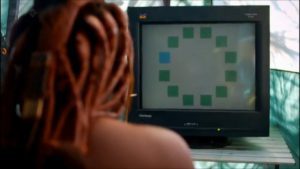 There’s Evidence Humans Didn’t Actually See Blue Until Modern Times The Himba tribe struggled to see blue, but can distinguish many more shades of green than many. “This all suggests that, until they had a word from it, it’s likely that our ancestors didn’t actually see blue. Or, more accurately, they probably saw it as we do now, but they never really noticed it. And that’s pretty cool.”
There’s Evidence Humans Didn’t Actually See Blue Until Modern Times The Himba tribe struggled to see blue, but can distinguish many more shades of green than many. “This all suggests that, until they had a word from it, it’s likely that our ancestors didn’t actually see blue. Or, more accurately, they probably saw it as we do now, but they never really noticed it. And that’s pretty cool.”
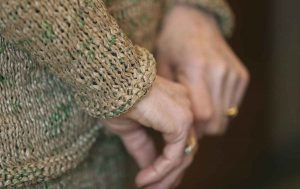 Knitting with a repurpose: Woman makes suit of plastic bags Rosa Ferrigno knit a suit from plastic grocery bags.
Knitting with a repurpose: Woman makes suit of plastic bags Rosa Ferrigno knit a suit from plastic grocery bags.
Please enjoy these goats on a slide. (links to a video on Twitter)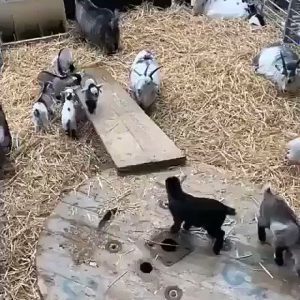
The post www: distinguishing blue; a new knitted suit; goats appeared first on knittyBlog.

March 26, 2019
Spring+Summer Knittyspin : Color and Combs
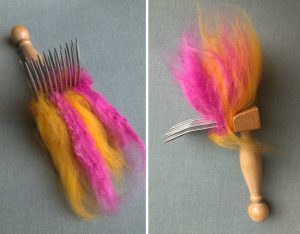 Loading combs for blending
Loading combs for blendingThe Spring + Summer issue of Knitty is live and that means a new Knittyspin column. This issue I explore how to load combs with fiber. More specifically, and so much closer to my heart, how to load commercially prepped fiber on combs for blending color.
Each way results in a different effect to the finished yarn. The number of combing passes contributes to how much the fibers are blended too.
Curious and ready to comb? Click on over and see the difference for your self.
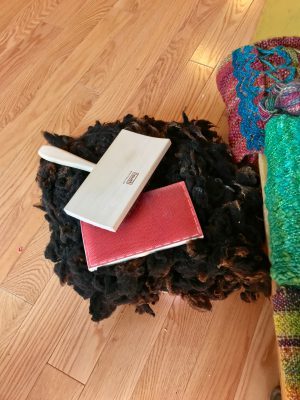 Yes, that is the whole fleece!
Yes, that is the whole fleece!
It seems like spring would never come! But now it’s here and there are fleeces to be had everywhere.
Are you fleece shopping this year or are you topped up on fleece?
I bought a tiny (1 lb) Shetland lamb fleece that I’m excited to wash and prep. I’m deciding between hand carding and drum carding.
The post Spring+Summer Knittyspin : Color and Combs appeared first on knittyBlog.

March 20, 2019
WWW: knitting robots ; unconventional weaving; periodic table of the elements
 Do robots dream of knitting? Knitting machines exist, but there’s something different about knitting with two sticks and string. At the University of Berlin (Germany), research by Dr. Pat Treusch is underway to determine how to teach a robot, PANDA, to knit. You can learn more about PANDA at Do robots dream of knitting? – Träumen Roboter vom Stricken?.
Do robots dream of knitting? Knitting machines exist, but there’s something different about knitting with two sticks and string. At the University of Berlin (Germany), research by Dr. Pat Treusch is underway to determine how to teach a robot, PANDA, to knit. You can learn more about PANDA at Do robots dream of knitting? – Träumen Roboter vom Stricken?.
 Can you weave that? For artist Anne Samat the answer is often yes. She mixes traditional yarns with unconventional materials like rattan sticks or metal.
Can you weave that? For artist Anne Samat the answer is often yes. She mixes traditional yarns with unconventional materials like rattan sticks or metal.
[Photo Anne’s work Freedom 1 … To Be Me (rattan sticks, yarns, washers, rakes, PVC chains, home (kitchen/garden) utensils and stationery items, 2017). Photo by: RK Fine Art]
 Jane Stewart created a stunning tribute to the periodic table of the elements out of thread! (Yes, it’s macramé!)
Jane Stewart created a stunning tribute to the periodic table of the elements out of thread! (Yes, it’s macramé!)
The post WWW: knitting robots ; unconventional weaving; periodic table of the elements appeared first on knittyBlog.

March 19, 2019
A Weaver’s Guide to Yarn
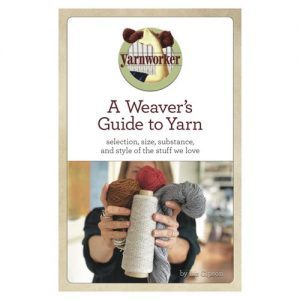 This book will save you yarn and heartbreak.
This book will save you yarn and heartbreak.I have weaving on my mind these days. I’m ready to fire up my Cricket rigid heddle loom with something gorgeous and easy. The project I’m starting is a combination of handwoven yarn and commercial yarn.
Choosing yarn is one of those things that can stop a new weaver from starting weaving. It’s overwhelming, and really we just want to use our stash or showcase our handwoven yarns.
A Weaver’s Guide to Yarn by Liz Gipson is a gem. It gives you the basics on how yarns work in weaving, and makes picking yarns a whole lot less stressful.
If picking yarn is keeping you from scratching your weaving itch, pick up this book, you’ll be weaving your stash in no time.
Here’s my review of the book from the latest issue of Knitty.
Weaver’s Guide to Yarn: Selection, Size, Substance, and Style of the Stuff We Love
by Liz Gipson
Yarnworker
$14-$19
Buy now at Yarnworker
One of the stress-filled bumps in the road for new weavers is picking yarn for projects. This little book will answer all of your questions about weaving yarns. Written by rigid-heddle powerhouse Liz Gipson, it demystifies which yarns to use for weaving. Pulling together excellent information from her already published books and adding much more, A Weaver’s Guide to Yarn will save newer weavers a whole lot of stress.
Liz outlines how yarn works in weaving, the make up and structure of yarn, explains terminology, and leads you to select the exact right yarn for your project. She does it all in such a friendly and clear way, you’ll wonder what you were ever worried about.
The book is divided into five sections. Selection addresses the basics for choosing yarns for warp and weft, including substitutions. Size discusses a lot of terminology associated with weaving yarns. Substance is about the fibers in yarns wool and beyond including linen, hemp, silk , synthetic, blends. Style breaks down how yarns are made and how it affects your weaving. Shopping talks about where and how much you need.
This book was written for rigid-heddle weavers, but all new and newish weavers can benefit from this book. It’s a fantastic overview of a complex subject.
The post A Weaver’s Guide to Yarn appeared first on knittyBlog.

March 13, 2019
WWW: ancient sewing needles; math & knitting; Philippine weaving
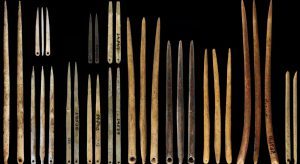 Sewing Needles Reveal the Roots of Fashion.
Sewing Needles Reveal the Roots of Fashion.
Not only were they used to sew seams, but also to provide embellishment.
(Photo: F. d’Errico/L. Doyon) [via JM]
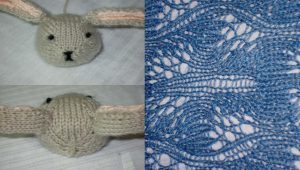 This article explores the research of Elisabetta Matsumoto.
This article explores the research of Elisabetta Matsumoto.
She looks into how different stitch types determine the stretch and shape of knitted items. Not only is it useful traditional knitting but also for material science.
(Photo: “Topological defects in the square can shape the (a) out-of-plane and (b) in-plane deformations of knitted textiles.” Elisabetta Matsumoto)
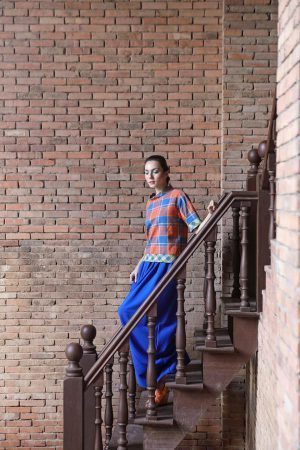 The Great Women Project Revives The Philippine Weaving Industry.
The Great Women Project Revives The Philippine Weaving Industry.
The textile and garment industry in the Philippines is almost non existent. This project aims to provide a sustainable livelihood to local weavers.
(Photo: Great Women Project)
The post WWW: ancient sewing needles; math & knitting; Philippine weaving appeared first on knittyBlog.

March 12, 2019
Schacht is 50! Class Openings Coming Up
Schacht Spindle Company turns 50 this year!
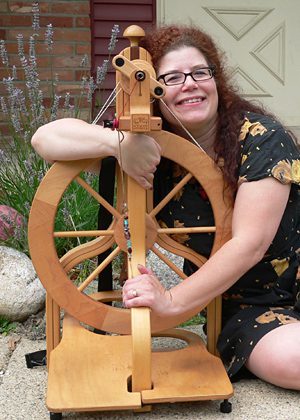 My beloved Matchless
My beloved MatchlessSchacht has been a huge part of my fiber life ever since the late 80s when I bought my first loom. But my true devotion didn’t start until I bought my Matchless sometime in the early 90s.
Soon (about five minutes) after I learned to turn fiber into a lumpy bit of yarn I saw my first Matchless.
It was lust at first sight. It was gorgeous, it was smooth. It could do all of these things that other spinners told me were good, but I would have no idea what they meant until years later.
I put that wheel on layaway and paid it off a little every month. I think it’s the most patient I’ve ever been in my life.
That wheel and I have been through thick and thin. The bad times were mostly due to my learning curve and inability to ask for help. She has never deserted me, no matter how thick I’ve been.
She sat patiently in my basement for a year while I decided if I wanted to be a spinner anymore. She was a trooper when my toddler son decided that she was the best thing to tackle to the ground over and over again.
She’s never stopped spinning smoothly. I did send her into Schacht for a bit of refresh and to get a quick release maiden put on, and she came back better than new. Schacht as a company has a commitment to quality and community. Sometimes spinners and weavers joke about how long it takes for a new product to come out, but we know it will be really right when we get our hands on it.
I wrote my first spinning book with her, and am now working on book number two with her help. I have a lot of other Schacht fiber products, a couple of Crickets, and I’m eyeing a Baby Wolf. Everything I own with the Schacht name on it is the highest quality, easy to use and visually beautiful. I own two other Schacht wheels (a Sidekick, and a Flatiron), that I use a lot and really like. While I might part with those wheels if my spinning slows down, I will never part with my Matchless.
Thanks Barry and Jane for so many wonderful years of creativity!
Spring and summer class openings
Spring and summer classes are going to be here before we know it! I have a few openings in some of my upcoming gigs.
There are openings in my Yarnitecture: The Full Monty (2 days, Tuesday and Wednesday) at PLY Away in April.
I have a one opening at Maryland Sheep and Wool. There is one spot in Light and Shadow: Hand Carding Tint, Tone and Shade on Friday. Here’s a link to the ticketing page.
There are still openings in my 15 hour Colorplay class at the Mid Atlantic Fiber Association conference in June.
Interweave files for bankruptcy
If you have heard the rumor that Interweave has filed for bankruptcy, it’s true and so sad. The company that owns Interweave, F&W Media filed for bankruptcy on Sunday. Here are a couple of articles talking about it.
The post Schacht is 50! Class Openings Coming Up appeared first on knittyBlog.

March 6, 2019
WWW: Drought & Navajo Shepherds; Handicraft Prize Winners; Ukiyo-e Search
 This article looks at the impact of drought on Navajo shepherds in the SouthWest.
This article looks at the impact of drought on Navajo shepherds in the SouthWest.
The Navajo Sheep Project set up a drought relief fund to help shepherds and their sheep sustain this latest challenge. via LG.
Photo: Irene Bennalley walks her herd of Navajo-Churro sheep out to grazing land where extreme drought has gripped the Four Corners region near Two Grey Hills, New Mexico. Brian van der Brug / Los Angeles Times
 Three keen needleworkers, all in their 90s, have come away with first and highly commended prizes for their handicrafts at the Newcastle (Australia) show.
Three keen needleworkers, all in their 90s, have come away with first and highly commended prizes for their handicrafts at the Newcastle (Australia) show.
Photo: Whiddon Redhead residents Linda Felton, Joyce Yates, and Sylvia Raisbeck all won prizes at the Newcastle show. Picture: Simone De Peak
 This isn’t exactly knitting related, but I think it’s an incredible resource. Ukiyo-e Search is a searchable Japanese Woodblock Database. If that wasn’t enough, you can also search by comparing similar images or even uploading a photo.
This isn’t exactly knitting related, but I think it’s an incredible resource. Ukiyo-e Search is a searchable Japanese Woodblock Database. If that wasn’t enough, you can also search by comparing similar images or even uploading a photo.
The post WWW: Drought & Navajo Shepherds; Handicraft Prize Winners; Ukiyo-e Search appeared first on knittyBlog.

March 5, 2019
New Spinning Tool: Thumb Flick
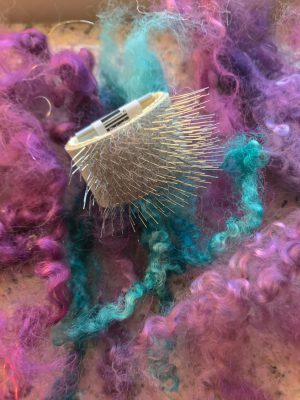 Thumb flick
Thumb flickThis past weekend I taught at Susan’s Fiber Shop Spinning Retreat, it was great fun!
At one point in the festivities Susan whipped out this cool little tool – a thumb flick.
It’s exactly what it sounds like, a tiny flick that slips over your thumb to use to tease open locks. I used it to flick open locks for blending board batts, and it worked perfectly.
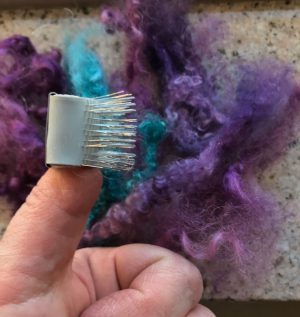 Ready to flick
Ready to flickIt’s tiny and light and costs about $10, what’s not to love?
I haven’t seen them anywhere else, and Susan just got them in. If you want one the quickest way is to call her shop.
Here’s Susan demonstrating her flick:
The post New Spinning Tool: Thumb Flick appeared first on knittyBlog.

February 27, 2019
WWW: a jumper for a guinea pig; the history of orange; celebrating repair
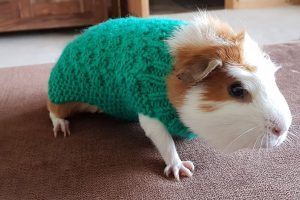 A knitting group is making jumpers for people’s unwell pets.
A knitting group is making jumpers for people’s unwell pets.
Gingernut the guinea pig looks rather fetching in his green jumper don’t you think?
 The History of the Color Orange offers a brief look at this bold and dynamic color.
The History of the Color Orange offers a brief look at this bold and dynamic color.
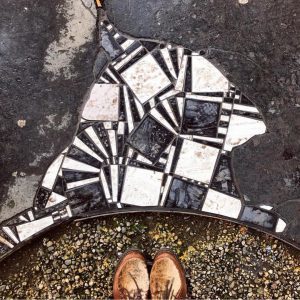 Grace Bonney of Design Sponge posted a fascinating floor to instagram. It reminded her of Kintsugi is the Japanese art of repairing pottery with gold, silver, or platinum. That had me thinking of visible mending. I turned to the knitty archives and found this 2006 article from our Kate Atherley, on Repairing Knitwear. Also of potential interest to knittyblog readers is Jillian’s review of Mending Matters: Stitch Patch and Repair Your Favorite Denim and More by Katrina Rodabaugh. There’s also Tom of Holland’s visible mending.
Grace Bonney of Design Sponge posted a fascinating floor to instagram. It reminded her of Kintsugi is the Japanese art of repairing pottery with gold, silver, or platinum. That had me thinking of visible mending. I turned to the knitty archives and found this 2006 article from our Kate Atherley, on Repairing Knitwear. Also of potential interest to knittyblog readers is Jillian’s review of Mending Matters: Stitch Patch and Repair Your Favorite Denim and More by Katrina Rodabaugh. There’s also Tom of Holland’s visible mending.
The post WWW: a jumper for a guinea pig; the history of orange; celebrating repair appeared first on knittyBlog.

February 26, 2019
Blending Board Fun: Making Roving
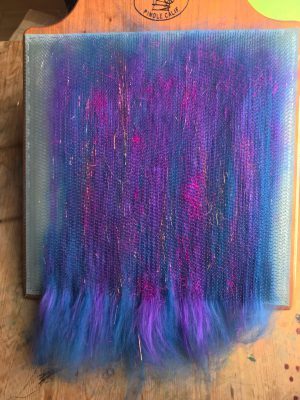 Layered fiber on my blending board
Layered fiber on my blending boardSpinners seem to be excited about blending boards again, those perfect rolags and mini batts are irresistable. I know I’ve been playing with mine after about a year of not even thinking about it much. I have a cherry Clemes and Clemes blending board that works perfectly every time.
I’ve been making smooth rolags, mini crazy batts with tons of add ins, and roving. Roving from a blending board? Yes, and it’s so quick.
It’s best to use a smoother type of fiber mixture when pulling roving off of a blending board. Noils, and sari silk threads are ok, but big lucious dyed locks don’t work as well.
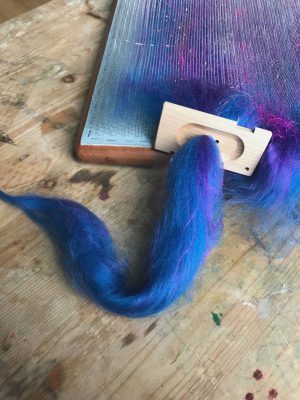 Dizzing!
Dizzing!For this roving I used some dyed Corriedale, bamboo, sari silk threads, and some sparkle.
I put my fibers on in thin layers and didn’t pack them as densely as I do when I’m rolling off rolags.
Once I’m done loading my board up, I start at one corner with a diz or a button, or a needle gauge, and start dizzing across the board, back and forth. I go slowly, pulling the fiber and pushing the diz back down. I go slowly, pulling the fiber with staple lengths in mind, so I don’t get breaks in the roving.
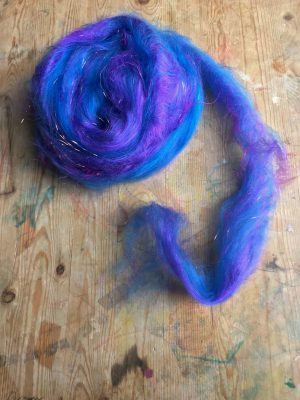 Dizzed roving, ready to spin.
Dizzed roving, ready to spin.
When I get to the top of the board, I wind my roving into a little nest, and start the process again.
Do you diz off of your blending board?
The post Blending Board Fun: Making Roving appeared first on knittyBlog.

Mandy Moore's Blog
- Mandy Moore's profile
- 6 followers



